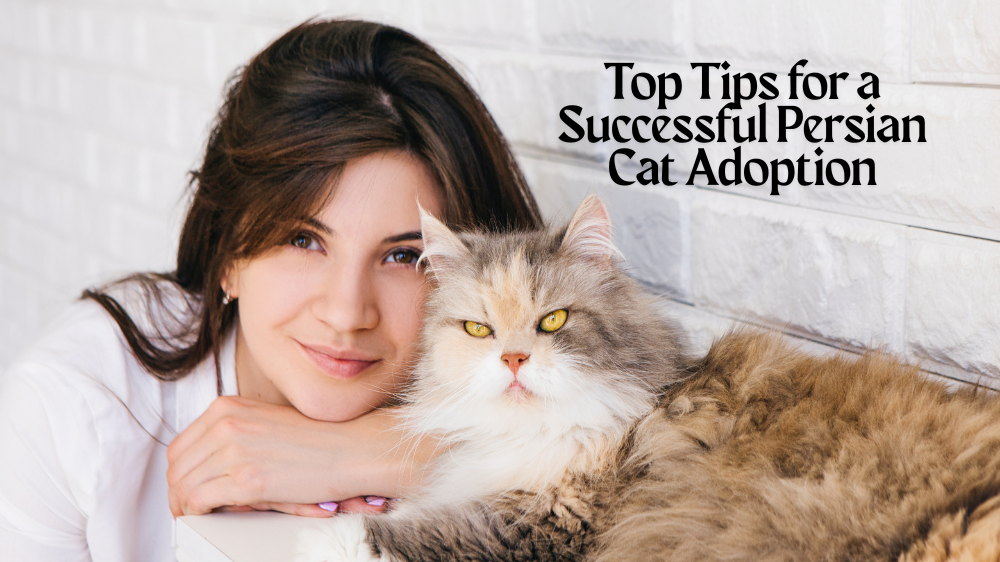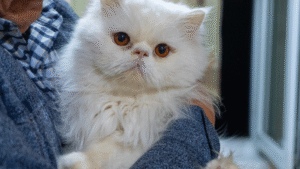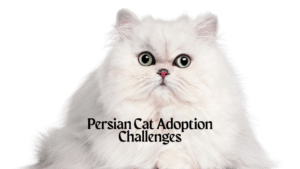The “Persian cat adoption” trend has been gaining popularity, with more people realizing the charm of these beautiful, fluffy companions. Persian cats are famous for their luxurious coats, sweet temperaments, and overall adorable appearance. They make great pets for families, single individuals, and even elderly people due to their gentle nature and relatively low activity levels.
This post will guide you through the essential Persian cat adoption tips that will help ensure your new Persian cat becomes a beloved member of your family. From understanding the Persian cat adoption challenges to mastering their grooming routine, we’ve got you covered.
So, whether you’re considering Persian kitten adoption or adopting an adult cat, let’s dive into the tips for a smooth adoption journey.
Why Choose Persian Cat Adoption?
“Persian cat adoption” is a wonderful way to provide a Persian cat a second chance and caring environment. Whether you have never owned a pet or are a dedicated cat enthusiast, these are just some of the reasons why a Persian could be the perfect fit:
1. Unique Personality and Companionship
One of the most enchanting things about “Persian cat adoption” is the fact that the breed is calm and affectionate. Persian cats are famous for their easygoing attitudes —they love peaceful settings and just want to quietly snuggle up with you.
Their gentle disposition means if your looking for a pet for an individual or family, you couldn’t ask for a more loving and undemanding companion. If you have a Persian cat, you can count on lots of snuggles and quiet times.
2. Emotional and Health Benefits
Taking in a Persian cat that needs a home is not only good for the soul; it’s definitely good for your health. According to several studies, having a cat around has a calming effect and can eliminate stress, lower blood pressure and evoke a smile.
A Persian cat’s soft touch can keep you feeling calm and peaceful after a long day at work. With ‘Persian cat adoption’ you get not only a pet but also a new family member and emotional stabilizer.
3. Ideal for Families
For families, including those with kids or other pets, Persian cat adoption is especially appropriate. Persian cats are well-known for their calm and tolerant attitude, adapt to the pace of every family member and can form a strong bond with children.
Raise a playful Persian kitten or a gentle giant as a true member of your family providing unconditional love, peace, and affection, unmatched from other breeds.
4. Adoption vs. Buying: A Meaningful Choice
Although it may appear easier to choose a breed through a commercial breeder, there are more compassionate and cost-effective options for Persian cat adoption. You give a cat a second chance at a loving home when you rescue or adopt from a shelter.
Shelters will usually give them full health checks and screen for the most common Persian cat sickness symptoms before making them available for rehoming. This is to ensure that your new kitty is healthy and ready for a fresh start with you.
When you decide to adopt instead of buy, you’re saving your wallet and giving support to a humane and ethical cause too.
Persian Cat Adoption Tips for Beginners
Thinking about “Persian cat adoption” for the first time? This luxurious, affectionate breed is a favorite among cat lovers, but adopting one does come with unique responsibilities. Here are essential Persian cat adoption tips to help you start your journey confidently and responsibly:
1. Choosing the Right Persian Cat
One of the first steps in the Persian cat adoption process is selecting a cat that suits your lifestyle. Whether you’re considering a playful Persian kitten or a calm adult cat, it’s crucial to assess their personality.
For first-time cat owners, adopting an older Persian cat may be a wiser choice. Adults are typically more settled, making the transition smoother and more manageable than the high energy and needs of kittens. Remember, successful Persian cat adoption begins with the right match.
2. Understanding Temperament and Behavior
An important aspect of “Persian cat adoption” is being aware of the breed’s temperament. Persian cats are known for their gentle, affectionate nature but can be reserved in new environments.
Don’t expect high-energy antics—these cats prefer peaceful settings, lounging in quiet corners, and soaking in affection. As a new adopter, give your Persian cat time to adjust. Patience and a calm environment will go a long way during the Persian cat adoption process, helping them feel secure and loved.
3. Grooming and Maintenance Tips
If you’re exploring Persian cat adoption, you must be prepared for their intensive grooming needs. Persian cats have long, luxurious coats that require consistent care. One of the most vital Persian cat adoption tips is to set aside time for grooming—at least 2 to 3 hours per week.
Regular brushing prevents painful matting, reduces shedding, and minimizes hairball issues. Proper grooming isn’t just about looks—it’s an essential component of overall Persian cat maintenance and well-being.
Final Advice for First-Time Adopters
Persian cat adoption is a meaningful and joyful experience, but it’s important to approach it with informed care. By choosing the right cat, understanding their unique behavior, and committing to their grooming needs, you’ll ensure a successful and fulfilling relationship with your new feline friend.
How to Adopt a Persian Cat: A Step-by-Step Guide
This detailed Persian cat adoption guide will show you how to adopt a Persian cat:
1.Research:
Begin with the search for a reputed adoption or rescue centers that deals with Persian cat adoption. Look up their reputation, read reviews and make sure they offer full health disclosure for the cats that are available for adoption. Seek out locales where the cats are looked after and have received proper vaccination.
2.Preparation:
Prep before you bring your Persian cat home! Create a safe, cozy space with a bed, food and water bowls, a litter box and a toy or two. Pet-proof your home and be prepared for the new arrival. If you are bringing home a Persian kitten there are some supplies you want to have on hand for it’s arrival so it can grow into a proper Persian.
3.Adoption Day:
When you bring your Persian cat home, there’s no need to have a big fanfare. Let them ease into their new environment on their own terms. Be patient and kind as they adjust to their new surroundings.
Be sure to give your Persian cat space, especially if you’re adopting an adult who needs time to adjust. A great deal is expected of anyone taking on a Persian “kitten” – you won’t be getting an old lady’s cat, but an inquisitive, lively youngster who will need time to adjust.
Preparing for Persian Cat Adoption: Home Setup Checklist
Embarking on your Persian cat adoption journey? Bringing home a Persian cat—whether a playful kitten or a serene adult—requires intentional planning and a welcoming environment.
This comprehensive Persian cat adoption guide outlines how to prepare your home to ensure a smooth and stress-free transition for your new feline companion.
🏠 1. Creating a Comfortable Space for Exploration and Rest
An important part of successful Persian cat adoption is ensuring your home is calm and cat-friendly. Persian cats enjoy having space to roam, but they don’t need large areas or constant stimulation.
Designate a quiet zone where they can rest undisturbed, along with a few spots where they can explore at their own pace. A tranquil home environment helps your Persian cat feel secure and eases the transition process.
📦 2. Must-Have Supplies Before Persian Cat Adoption
To prepare properly for Persian cat adoption, gather these essential items ahead of time:
- ✔️ Litter Box: Choose a clean, accessible litter box that is easy for your Persian cat to use. Keep it in a quiet, private area and maintain it regularly to promote hygiene and comfort.
- ✔️ Food & Water Bowls: Invest in stable, easy-to-clean bowls. Persian cats can be sensitive about their food, so offer high-quality, nutritious meals and always provide freshwater.
- ✔️ Toys & Scratching Posts: Though Persian cats are known for their calm demeanor, they still need mental stimulation and an outlet for natural scratching behaviors. Provide toys and a sturdy scratching post to keep them engaged and content.
- ✔️ Grooming Tools: Grooming is a vital part of “Persian cat adoption” preparation. These cats have long, luxurious coats that require daily or frequent brushing. Purchase a metal comb and soft-bristle brush to prevent matting and maintain their fur health.
🌿 3. Setting Up a Peaceful Environment
Another key step in Persian cat adoption is ensuring your home promotes a calm and stress-free atmosphere. Loud noises and busy activity can overwhelm a new cat—especially a breed as gentle as the Persian. Designate a quiet corner with their bed, toys, food, and litter box to give them a sense of territory and comfort.
A successful Persian cat adoption experience begins with preparation. By thoughtfully setting up your home, gathering the right supplies, and creating a peaceful space, you’ll help your new companion adjust quickly and feel right at home. The more prepared you are, the more fulfilling the adoption journey will be—for both you and your Persian cat.
Persian Cat Age and Lifespan: What to Know Before Adopting
Before beginning your Persian cat adoption journey, it’s important to understand how age and lifespan affect your responsibilities as a pet parent. Whether you’re considering a curious Persian kitten or a serene senior cat, knowing what to expect at different life stages will help you make an informed and thoughtful decision.
⏳ Understanding Lifespan
Persian cats are known for their longevity and resilience. On average, they live between 12 and 17 years, and with exceptional care, some can live well into their 20s. When preparing for Persian cat adoption, recognize that this is a long-term commitment. Providing a stable, nurturing home can greatly impact their quality of life and lifespan.
🍼 Persian Kittens vs. Adult Cats
The age of the cat you adopt plays a key role in how you’ll need to care for them:
- Adopting a Persian Kitten: If your Persian cat adoption involves a kitten, be prepared for a more time-intensive experience. Kittens require frequent feeding, litter training, socialization, and more consistent supervision. While they bring playful energy and a chance to shape their behavior from a young age, they also demand patience and structure during their formative months.
- Adopting an Adult or Senior Persian Cat: Adult Persian cats are often more relaxed and accustomed to household routines. They may need less behavioral training but can have age-related health issues, such as joint stiffness or dental concerns. As part of your “Persian cat adoption” plan, ensure you’re ready to provide regular veterinary care and monitor for signs of aging.
🩺 How Age Affects Care and Maintenance
Age directly influences the level of Persian cat maintenance required. Kittens need stimulation, developmental support, and gentle discipline. On the other hand, older cats may need special diets, routine health screenings, and comfort-focused living arrangements.
Regardless of age, proper grooming, nutrition, and emotional care are essential pillars of responsible Persian cat adoption.
Persian Cat Maintenance and Health: What to Expect After Adoption
Adopting a Persian cat is not just about bringing home a beautiful companion—it’s about making a long-term commitment to their health, grooming, and overall well-being.
Proper Persian cat maintenance is essential after completing the Persian cat adoption process, especially if you want your feline friend to enjoy a healthy and comfortable life.
This section outlines the key aspects of care you should expect after Persian kitten adoption or adult Persian cat adoption, including grooming routines, common health issues, and medical check-ups.
✂️ Grooming Routines and Essential Tools
After “Persian cat adoption”, one of the most important responsibilities you’ll take on is grooming. Persian cats have luxurious, long coats that require daily to weekly maintenance to prevent tangles and mats.
Key grooming tips:
- Use a high-quality stainless-steel comb, a soft-bristle brush, and a de-matting tool if needed.
- Regular brushing helps reduce hairballs and excessive shedding, which is common in Persian cats.
- Cleaning the eyes daily is essential due to their flat facial structure, which often leads to tear staining.
- Consistent grooming is not just about appearance—it’s a crucial part of Persian cat maintenance and comfort.
🏥 Common Health Concerns in Persian Cats
When planning for Persian cat adoption, it’s important to be aware of breed-specific health challenges. Persian cats are known for their gentle demeanor, but their unique anatomy makes them prone to several health issues. Understanding Persian cat sickness symptoms is key to early intervention.
Common health concerns include:
- Brachycephalic Airway Syndrome: Their flat-faced appearance can cause breathing difficulties, especially in hot or stressful conditions. Monitor for snoring, labored breathing, or excessive panting.
- Polycystic Kidney Disease (PKD): PKD is a genetic disorder common among Persian cats. Symptoms may include increased thirst, appetite loss, or lethargy. Regular screenings are crucial, particularly for older cats.
- Eye Conditions and Dental Issues: Excessive tearing, eye infections, and gum disease are also common. Regular eye cleaning and dental checks are part of responsible Persian cat care.
🧬 Lifespan, Age-Related Care & Routine Vet Visits
Understanding the Persian cat age and lifespan helps tailor your care. Most Persian cats live 12–17 years, and some can exceed 20 years with proper attention and medical support. Whether you’re adopting a kitten or a senior cat, age influences everything from grooming needs to vet care frequency.
Health maintenance tips:
- Schedule routine veterinary visits every 6–12 months.
- Keep up with vaccinations, parasite prevention, and annual blood work, especially as your Persian cat ages.
- Use a Persian cat age chart to track milestones and ensure you’re meeting the cat’s age-specific needs.
- Regular check-ups can help detect early signs of illness and reduce long-term healthcare costs.
Post-adoption care is a core component of “Persian cat adoption” success. Investing time in grooming, staying alert to potential Persian cat sickness symptoms, and scheduling consistent vet visits will help your cat thrive for years to come.
With the right knowledge, tools, and love, your commitment to proper Persian cat maintenance will be rewarded with a healthy, elegant, and deeply affectionate companion.
Persian Cat Adoption Challenges: How to Overcome Them
“Persian cat adoption” is a heartwarming and life-enhancing journey, but it does come with a unique set of challenges—especially for first-time cat owners.
Whether you’re exploring Persian kitten adoption or bringing home an older feline companion, it’s important to prepare for common issues that may arise. With the right knowledge and care, you can turn challenges into opportunities for bonding.
This section serves as a critical part of your overall Persian cat adoption guide, particularly helpful for those seeking Persian cat adoption tips for beginners.
🐾 1. Behavioral Challenges: Shyness or Withdrawal
One of the most common Persian cat adoption challenges is helping your new cat adjust to unfamiliar surroundings. Persian cats—especially adults adopted from shelters—may appear reserved, anxious, or shy at first.
How to Overcome It:
- Set up a calm, quiet room where your cat can feel safe—this is a key step in preparing for Persian cat adoption.
- Avoid loud noises and let your cat explore new spaces at their own pace.
- Use positive reinforcement and a predictable routine to build trust.
- Refer to Persian cat adoption tips to ensure a smooth integration process.
🕒 2. Adjustment Period and Routine Building
Understanding how to adopt a Persian cat goes beyond paperwork—it’s about helping them transition into a stable lifestyle. Persian cats are sensitive to change and may exhibit stress when moved to a new environment.
How to Overcome It:
- Establish a daily schedule that includes feeding, grooming, and bonding time.
- Be patient and consistent. A structured environment reduces anxiety and helps the cat feel secure.
- Watch for early warning signs such as hiding, restlessness, or changes in appetite, which may resemble Persian cat sickness symptoms but are often just signs of adjustment.
🩺 3. Health-Related Challenges
Health is a critical aspect of Persian cat maintenance. The breed is prone to several hereditary conditions such as:
- Polycystic Kidney Disease (PKD)
- Brachycephalic airway syndrome (due to their flat-faced appearance)
- Eye discharge, tear staining, and dental issues
How to Overcome It:
- Schedule regular veterinary checkups, particularly for older cats. Use the Persian cat age chart to monitor age-related health milestones.
- Keep grooming consistent—this includes brushing, eye cleaning, and dental care.
- Learn to recognize Persian cat sickness symptoms early, such as breathing difficulty, excessive drooling, or lethargy.
💸 4. Cost Awareness and Financial Planning
While “Persian cat adoption” is generally more affordable than purchasing from a breeder, it still comes with ongoing expenses. Beyond the initial Persian cat price, you’ll need to budget for grooming supplies, high-quality food, medical bills, and maintenance.
Tip: Choosing adoption not only lowers your upfront cost but also supports animal welfare. Most rescue centers ensure the cat is vaccinated and screened for health issues before completing the Persian cat adoption process.
Table: Key Factors in Persian Cat Adoption
| Factor | Description | Tips for Adoption |
| Age of Persian Cat | Kittens vs. Adults | Consider your time commitment and experience level. |
| Personality | Independent vs. Social | Choose a cat whose temperament suits your lifestyle. |
| Health Conditions | Common issues in Persian cats (e.g., PKD) | Adopt from a reputable source that tests for health issues. |
| Grooming Needs | Daily brushing required | Prepare for regular grooming sessions, especially long-haired Persians. |
| Adoption Costs | Adoption fees, initial expenses | Factor in costs for medical bills, grooming tools, etc. |
Persian Cat Price: How Much Should You Expect to Pay for Adoption?
When considering Persian cat adoption, understanding the associated costs is essential for planning a successful and responsible transition. While adopting a Persian cat is often more affordable than purchasing from breeders, it still involves several financial considerations.
Adoption Fees
The adoption fees for Persian cats vary widely depending on factors such as the shelter or rescue organization, geographic location, and the cat’s age or health status.
Typically, adoption fees range from $50 to $150, which is considerably more budget-friendly than the Persian cat price at breeders, where costs can be several times higher.
Adopting through a shelter also means you’re supporting animal welfare efforts and giving a loving Persian cat a second chance at a happy home.
Breeders vs. Rescue Centers: Cost and Value
While breeders may charge premium prices for Persian cats—often reflecting pedigree, lineage, and show-quality traits—”Persian cat adoption” from rescue centers is a compassionate and economical alternative.
Rescue centers usually include vaccinations, initial health screenings, and spaying or neutering in their fees, adding value beyond just the price.
Additional Costs to Consider After Adoption
Beyond the initial adoption fee, be prepared for ongoing expenses that are vital for your Persian cat’s health and comfort. These include:
- Grooming Supplies: Due to their thick, long coats, Persian cats require regular grooming tools such as combs, brushes, and de-matting equipment.
- Quality Food and Water: Investing in nutritious cat food tailored to Persian cats’ dietary needs supports their longevity and well-being.
- Veterinary Care: Routine vet visits, vaccinations, and occasional treatments for common Persian cat sickness symptoms are crucial components of Persian cat maintenance.
- Other Supplies: Litter boxes, toys, scratching posts, and comfortable bedding.
Remember, the cost of care after Persian cat adoption often surpasses the initial adoption fee but is necessary for ensuring a happy and healthy life for your new feline companion.
How to Spot Persian Cat Sickness Symptoms Early
One of the most important responsibilities after Persian cat adoption is monitoring your new companion for any signs of illness. Recognizing Persian cat sickness symptoms early can make a significant difference in your cat’s health and quality of life.
Whether you have adopted a Persian kitten or an adult cat, staying alert to subtle changes is crucial for successful Persian cat maintenance.
Here are some common Persian cat sickness symptoms to watch for after your Persian cat adoption:
🩸 Excessive Drooling
Following Persian cat adoption, be attentive if your cat starts to drool excessively. This symptom can indicate dental problems or respiratory issues, which Persian cats are prone to due to their facial structure. Early detection ensures timely vet care and prevents further complications.
🫁 Coughing or Lethargy
After “Persian cat adoption”, coughing or unusual tiredness may be signs of respiratory infections or heart conditions. Because Persian cats often experience breathing difficulties related to their brachycephalic anatomy, these symptoms require prompt veterinary attention as part of your ongoing Persian cat maintenance.
🍽️ Appetite Changes
A sudden change in appetite is a red flag post-Persian cat adoption. If your cat stops eating or shows less interest in food, it could point to illness or discomfort. Monitoring feeding habits closely helps ensure early intervention, protecting your cat’s health and wellbeing.
Final Thoughts on Persian Cat Adoption Health Monitoring
Successful Persian cat adoption involves more than just bringing a cat home—it requires diligent observation and care. By knowing how to identify early Persian cat sickness symptoms, you can provide the best care and help your Persian cat thrive for years to come.
Regular veterinary check-ups combined with attentive home monitoring form the foundation of effective Persian cat maintenance after adoption.
Conclusion
Adopting a Persian cat is a fulfilling experience that requires preparation, understanding, and patience. By following the Persian cat adoption tips shared in this post, you can ensure a smooth transition for your new pet and build a strong, loving bond.
Whether you’re preparing for Persian kitten adoption or welcoming an adult Persian cat, make sure to provide the best care and a safe, loving environment. Adopting responsibly is the first step towards offering a Persian cat a forever home.
If you’re ready to take the next step in your Persian cat adoption journey, start by researching adoption centers and rescue organizations near you.
Give a Persian cat the love and care they deserve, and experience the joy of having a loyal, affectionate companion by your side. Adopt today, and give a Persian cat a forever home!
FAQs:
Q1: What are the things I should do before getting a Persian kitten?
Be certain that the kitten has received all appropriate vaccinations and health checks. Expect lots of grooming and routine trips to the vet.
Q2: How can I handle the first transition for my Persian cat?
Give them time to settle in to their new environment and a quiet place to go when they need to rest.
Q3: Can you leave Persian cats alone?
Persian cats are gregarious and do not like to be left alone for long. Make sure someone can keep them company or purchase puzzle toys to amuse them.
Q4: Are Persian cats good with kids?
Yes! Persian cats are gentle and placid and are great with families.
Q5: What Persian cat health problems are there?
Watch out for problems like dental problems, respiratory issues and kidney disease that Persians are prone to








